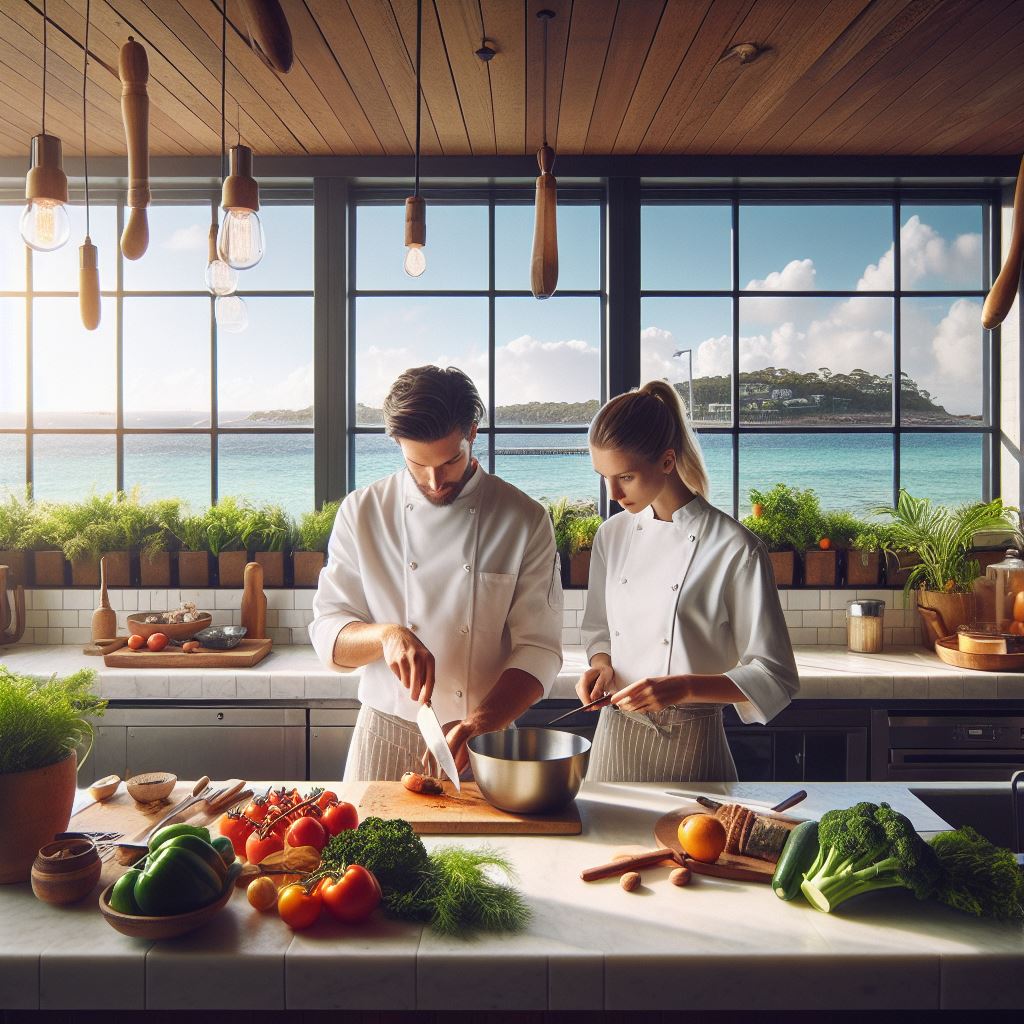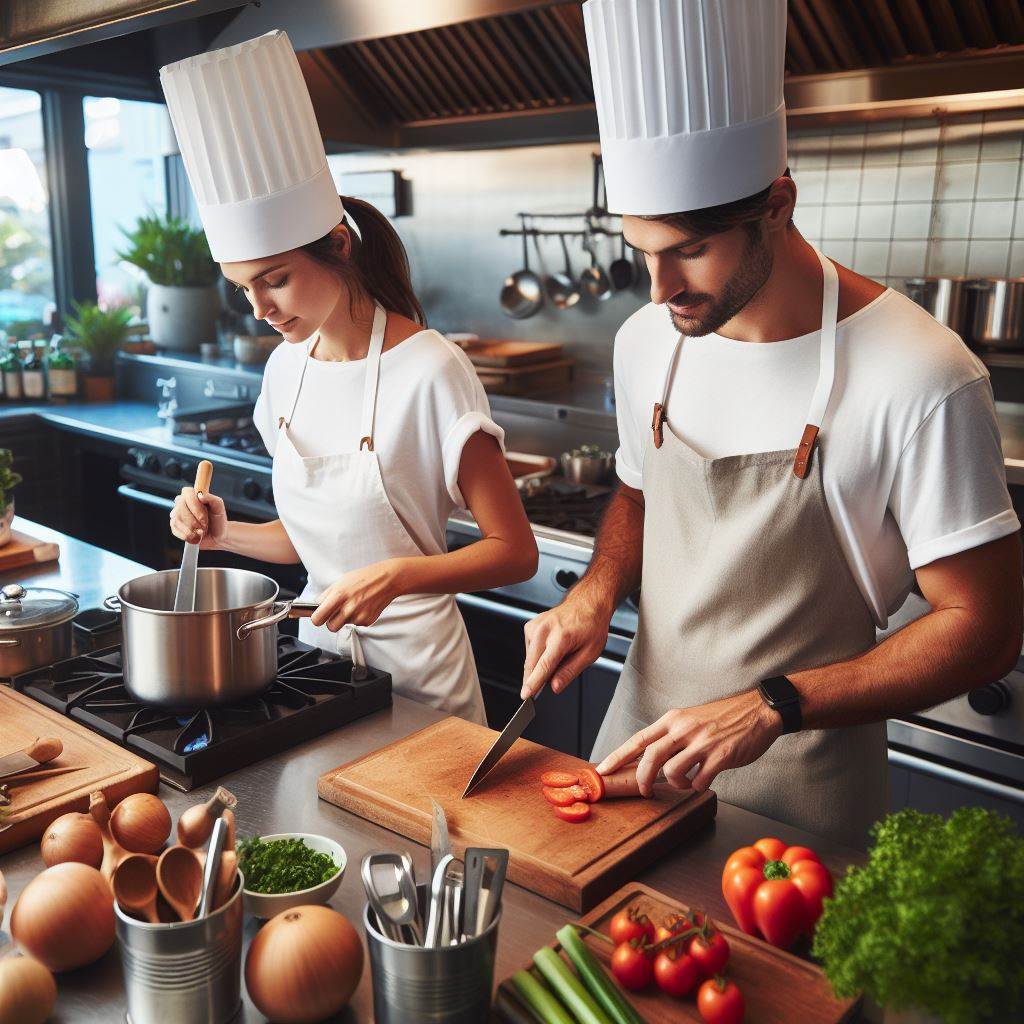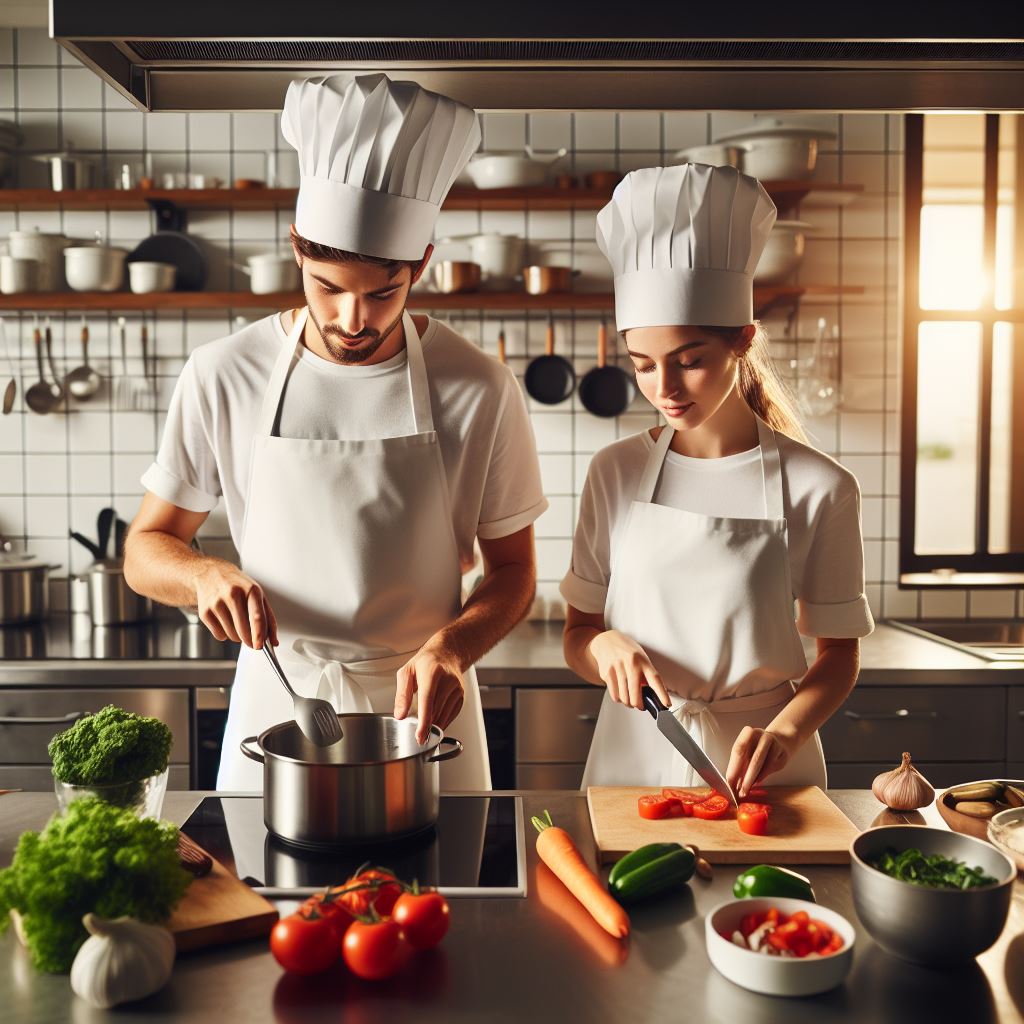Introduction
Mastering cooking techniques is crucial for Aussie chefs navigating Australia’s dynamic culinary landscape. Understanding these methods is essential.
Cooking techniques enhance flavors, perfect textures, and showcase ingredients in dishes. Aussie chefs rely on these skills.
From searing to baking, these techniques are the foundation of culinary creativity. Heat control and timing are crucial.
Grilling steaks, roasting vegetables, and crafting sauces require practice, precision, and ingredient knowledge. Aussie chefs innovate.
They draw inspiration from diverse culinary traditions, blending them with global influences. Mastery allows adaptation.
From classic barbecues to fusion cuisine, techniques are versatile. This guide explores each method intricately.
Understanding these skills is vital for chefs, whether seasoned or aspiring. It unlocks culinary success and innovation.
Aussie chefs embrace these techniques daily in Melbourne’s bustling kitchens and Sydney’s coastal restaurants.
With dedication and passion, they push culinary boundaries, striving for excellence. Proficiency in techniques is honored.
This section equips chefs with essential skills for success in Australia’s vibrant culinary scene. Prepare for a culinary adventure!
Basic Cooking Techniques
Every Aussie chef must have a solid foundation in fundamental cooking techniques. These techniques form the building blocks of creating delicious and impressive dishes. In this section, we will discuss some of the essential techniques that every chef should be familiar with.
Sautéing
- Sautéing involves cooking food quickly in a small amount of fat over high heat.
- It is important to have a hot pan and evenly cut ingredients to ensure quick and even cooking.
- This technique is great for stir-fries, searing meats, and sautéing vegetables to retain their crispiness.
Roasting
- Roasting refers to cooking food in an oven, usually at higher temperatures.
- This technique is perfect for meats, poultry, and vegetables, resulting in a crispy exterior and tender interior.
- It is crucial to monitor the cooking time and temperature to achieve the desired level of doneness.
Grilling
- Grilling, also known as barbecuing, involves cooking food directly over an open flame or hot coals.
- It is essential to preheat the grill and oil the grates to prevent sticking.
- Grilling enhances the natural flavors of meats, seafood, and vegetables, giving them a smoky and charred taste.
Steaming
- Steaming is a gentle cooking technique that involves cooking food with the steam produced by boiling water.
- This method helps retain the natural flavors, colors, and nutrients of ingredients.
- It is important to have a tightly sealed lid to trap the steam and cook the food evenly.
Understanding heat control and timing is vital in these cooking techniques. The proper control of heat ensures that food is cooked evenly and avoids burning or undercooking.
Timing is crucial to achieving perfect results. Each technique requires a different cooking time, and chefs should follow recipes or guidelines to ensure the best outcome.
Executing these basic cooking techniques with finesse and precision is what separates a good chef from a great one. As an Aussie chef, mastering these techniques will give you the confidence to create amazing dishes that will impress your guests and elevate your culinary skills.
Knife Skills
Knife skills are essential in a chef’s repertoire, contributing greatly to their success in the kitchen.
- Efficiency: Precise knife skills allow chefs to work quickly and efficiently, saving valuable time during food preparation.
- Presentation: Properly executed knife cuts result in aesthetically pleasing dishes, enhancing their presentation to diners.
- Consistency: Mastering knife skills ensures consistent sizes and shapes of ingredients in recipes, promoting even cooking.
- Texture: Skillful knife work can create desired textures, such as delicate chiffonade or fine brunoise.
- Uniformity: Well-practiced knife skills contribute to uniformity in food sizes, ensuring even cooking times.
Now let’s explore some essential knife cuts that every Aussie chef should know:
Your Personalized Career Strategy
Unlock your potential with tailored career consulting. Get clear, actionable steps designed for your success. Start now!
Get StartedJulienne
Julienne is a knife cut that produces long, thin strips of vegetables or other ingredients. It is commonly used in stir-fries and salads, adding visual appeal and texture.
Dice
Dicing involves cutting ingredients into small, uniform cubes. This knife cut is ideal for soups, stews, and casseroles, providing even cooking and distribution of flavors.
Chiffonade
Chiffonade is a technique used to cut leafy greens or herbs into thin, ribbon-like strips. It adds elegance and texture to dishes like salads, pasta, and garnishes.
Brunoise
Brunoise is a precise knife cut resulting in tiny cubes, usually around 1/8 inch in size. It is excellent for garnishes and adding small bursts of flavor and texture to dishes.
Each of these knife cuts requires practice and precision to master. However, the effort pays off in the quality of your culinary creations.
Besides the aesthetic value, mastering knife skills can significantly impact cooking efficiency:
- Speed: Efficient knife skills allow for faster ingredient preparation, reducing overall cooking time.
- Accuracy: Precise cuts ensure ingredients cook evenly, preventing undercooking or overcooking in a dish.
- Safety: Proper knife skills reduce the risk of accidents, as sharp knives are easier to control.
- Waste Reduction: Precise cuts yield less waste, maximizing the use of ingredients and reducing costs.
To improve your knife skills, consider the following tips
- Invest in Quality Knives: High-quality knives make a significant difference in your ability to achieve precise cuts effortlessly.
- Practice Knife Grip: Hold the knife firmly but comfortably, with your index finger resting along the spine for control.
- Keep Knives Sharp: A sharp knife is safer and more effective. Regularly sharpen and hone your knives to maintain their edge.
- Use Cutting Boards: Use a stable cutting board to protect your knives and make chopping more efficient and safe.
- Master Basic Techniques: Start with the fundamentals, such as the rock-chop, before progressing to more complex cuts.
Therefore, knife skills play a vital role in a chef’s repertoire. Mastering various knife cuts improves not only the presentation but also the efficiency of cooking. Practice, patience, and proper technique are key to becoming a skilled Aussie chef.
Sauce-making Techniques
In the culinary world, sauce-making techniques are an essential skill that every Aussie chef must know. Mastering these techniques can elevate the flavors of dishes and add depth to any meal. Let’s explore some of the key sauce-making techniques that every chef should be familiar with.
Reduction
Reduction is the process of simmering a liquid to concentrate its flavors and thicken the consistency. It involves gradually evaporating the liquid, which intensifies the flavors and creates a rich, thick sauce. Reduction is commonly used to make sauces like red wine reduction or balsamic glaze.
Emulsification
Emulsification is the process of combining two immiscible substances, such as oil and water, into a stable mixture. It is achieved by slowly adding one ingredient to another while vigorously whisking or using an emulsifier like egg yolks or mustard. This technique is used to create mayonnaise, vinaigrettes, and creamy sauces.
Deglazing
Deglazing is the method of adding liquid to a hot pan to loosen and dissolve the flavorful browned bits left after sautéing or searing meat. It is commonly done using alcohol like wine or spirits, which helps to enhance the taste of the sauce. Deglazing is often used in making pan sauces or gravies.
Beurre Blanc
Beurre Blanc is a classic French sauce made by whisking cold butter into a reduction of vinegar, white wine, and shallots. This technique creates a smooth, velvety sauce with a rich buttery flavor. Beurre Blanc is a versatile sauce that pairs well with fish, poultry, and vegetables.
Hollandaise
Hollandaise is a luxurious sauce made from melted butter, egg yolks, and lemon juice. It is prepared using a double boiler or a heatproof bowl over simmering water, whisking constantly to create a creamy, tangy sauce. Hollandaise is a classic accompaniment to eggs Benedict, asparagus, and grilled fish.
Tomato Concassé
Tomato concassé is a technique where tomatoes are blanched, peeled, seeded, and diced. This method enhances the texture and flavor of tomatoes, which can then be used as a base for tomato sauces, salsas, or soups. Tomato concassé adds freshness and brightness to dishes.
Stand Out with a Resume That Gets Results
Your career is worth more than a generic template. Let us craft a resume and cover letter that showcase your unique strengths and help you secure that dream job.
Get HiredVelouté
Velouté is a basic sauce made by thickening a light stock, such as chicken or veal, with a roux made from equal parts butter and flour. This technique creates a smooth, creamy sauce that serves as a base for various derivative sauces like béchamel or sauce suprême.
Mastering sauce-making techniques is crucial for every Aussie chef looking to take their culinary skills to the next level. Reduction, emulsification, deglazing, and other techniques discussed in this section can transform simple dishes into restaurant-quality creations.
So, grab your whisk and saucepan, and start experimenting with these techniques to elevate the flavors of your favorite recipes!
Read: Navigating COVID-19: Travel Agents’ Advice
Baking and Pastry Techniques
When it comes to being a skilled Aussie chef, mastering the art of baking and pastry is essential.
These techniques require precision, attention to detail, and a creative touch. Let’s explore some of the essential skills and techniques every Aussie chef must know in this area.
Dough-Making
- Understanding the science behind dough-making is crucial for creating perfect breads, pastries, and desserts.
- Knowing how to measure and combine ingredients accurately ensures consistent results every time.
- Mastering different techniques, such as kneading, folding, and proofing, allows chefs to achieve desired textures.
Pastry Rolling
- Rolling out pastry requires finesse to achieve the right thickness and evenness.
- A light touch while handling pastry dough prevents toughening and overworking, resulting in a flaky texture.
- Proper chilling and resting of the dough before rolling helps maintain its structure and prevent shrinkage.
Decorating
- Decorating baked goods and pastries adds the finishing touch to elevate their visual appeal.
- Techniques such as piping, icing, and glazing allow chefs to create intricate designs and patterns.
- Having an eye for aesthetics and color palettes helps in creating visually stunning desserts.
Attention to Detail and Precision
In baking and pastry work, attention to detail and precision are of utmost importance. Here’s why
- Accurate measurement of ingredients affects the overall taste and texture of the final product.
- Following precise recipe instructions ensures consistent results and avoids potential disasters.
- Paying attention to cooking times and temperatures prevents over or under-baking.
- Being meticulous in decorating ensures beautiful presentations that delight both the eyes and taste buds.
- Applying precision in dough-making techniques leads to perfectly textured pastries and breads.
Aussie chefs must understand that practicing patience, perfecting their techniques, and honing their baking and pastry skills are essential for success in the culinary world.
In review, baking and pastry techniques play a pivotal role in the repertoire of every skilled Aussie chef. From mastering the art of dough-making to creating visually stunning decorations, attention to detail and precision are crucial.
By honing these skills, Aussie chefs can create delectable treats that leave a lasting impression on their customers.
Read: Travel Insurance Tips from Expert Agents

Explore Further: Technology in Tour Guiding: A Boon?
Grilling and BBQ Techniques
In Australian cuisine, grilling and BBQ techniques are a significant part of creating delicious dishes with distinct flavors. Understanding these techniques can elevate your cooking skills and impress your friends and family with your culinary expertise.
Explore the Art of Grilling and BBQ Techniques
Grilling is not just about cooking meat over an open flame; it is an art that requires finesse and knowledge. By mastering different grilling methods, you can create mouthwatering dishes that will leave everyone wanting more.
Direct Grilling
This is the most common grilling method where the food is cooked directly over the heat. It produces a seared exterior and a juicy, flavorful interior. Perfect for steaks, burgers, and vegetables.
Indirect Grilling
In this method, the food is cooked next to, rather than directly over, the heat source. It offers slower cooking at a lower temperature, resulting in tender cuts of meat with a smoky aroma. Ideal for large cuts of meat and poultry.
Smoking Techniques
Smoking enhances the flavor of meats, seafood, and even vegetables. By using wood chips or chunks, you can infuse a smoky taste into your food. Some popular options include mesquite, hickory, apple, and cherry wood.
Transform Your LinkedIn for Maximum Impact
Elevate your professional brand with a LinkedIn profile that attracts recruiters, showcases your expertise, and maximizes opportunities. Stand out in your industry with a profile built for success.
Boost ProfileKnowledge of Different Wood Flavors
Understanding the characteristics of various wood flavors can help you choose the right ones to complement your dishes. For example, mesquite wood lends a robust and strong flavor, while apple wood provides a delicate and sweet aroma.
Creating Distinct Flavors in Grilled Dishes
Mastering grilling and BBQ techniques allows you to experiment with different flavors and create unique dishes that reflect your culinary style. Here are a few tips
Marinating and Seasoning
Marinating meat before grilling adds flavor and moisture to the final dish. Experiment with different marinades and seasonings to enhance the taste of your grilled creations.
Caramelization
Mastering caramelization is key to achieving a perfect sear on your grilled dishes. This process enhances the flavors by creating a rich, golden-brown crust.
Basting and glazing
Basting and glazing your grilled items with sauces, marinades, or oils can add an extra layer of flavor and moisture. Brush the sauce on while the food is still on the grill for better absorption.
Temperature control
Controlling the heat is crucial to achieving the desired doneness in your grilled dishes. Use a thermometer to ensure your meats are cooked to perfection without drying them out.
Resting
Allow your grilled meats to rest for a few minutes after cooking. This allows the juices to redistribute, resulting in tender and flavorful bites.
By exploring the art of grilling and BBQ techniques, you can elevate your culinary skills and create a range of delicious dishes.
Whether you prefer direct grilling, indirect grilling, or smoking, understanding these techniques will help you achieve the perfect char, smoky flavor, and juicy tenderness in your grilled creations. So, fire up the grill and get ready to impress with your newfound knowledge!
Read: Why Use a Travel Agent for Business Trips?
Plating and Presentation Skills
Plating and presentation are crucial aspects of the culinary world that can make or break a dining experience. It is no secret that people eat with their eyes first, and a well-presented dish can enhance the overall enjoyment of a meal.
Therefore, every Aussie chef must know and master the art of plating and presentation.
The Importance of Plating and Presentation
Plating and presentation are not just about making a dish look pretty; they play a vital role in the overall dining experience. When a plate is visually appealing, it stimulates the appetite and creates anticipation for the flavors to come.
A visually stunning dish also elevates the perception of the entire dining establishment and sets it apart from the competition.
Furthermore, plating and presentation can highlight the chef’s skills and creativity. It showcases their attention to detail and their ability to harmoniously arrange elements on a plate. It is an opportunity for chefs to express their unique style and culinary vision.
Various Plating Techniques
There are endless possibilities when it comes to plating techniques, each adding its own flair to a dish. Here are a few commonly used techniques:
- Stacking: This technique involves carefully layering different components to create height and visual interest. Stacking can add a sense of sophistication to a dish.
- Drizzling: Drizzling sauces or oils on a plate helps to add flavor, texture, and aesthetic appeal. It can create beautiful patterns and enhance the overall presentation.
- Garnishing: Garnishes such as herbs, edible flowers, or microgreens are used to add color, freshness, and flavor to a dish. They can also provide a pleasing contrast in texture and taste.
Chef’s Creativity and Attention to Detail
A chef’s creativity and attention to detail are key factors that separate exceptional dishes from ordinary ones. A creative chef can turn an ordinary ingredient into a work of art. They understand the importance of using various colors, textures, and shapes to create visually appealing plates.
Additionally, a chef’s attention to detail extends beyond just the appearance of a dish. They consider the balance and harmony of flavors, the proper use of seasoning, and the overall composition of the plate.
It is through their meticulous planning and execution that they elevate the dining experience.
Ultimately, plating and presentation skills not only make a dish visually appealing but also enhance the flavors and textures, creating a memorable dining experience. Aussie chefs who master these skills have a greater chance of standing out in the competitive culinary industry.
Essentially, plating and presentation are crucial aspects of the culinary world that every Aussie chef must know. The importance of these skills goes beyond aesthetics, as they greatly contribute to the overall dining experience.
Through various plating techniques, such as stacking, drizzling, and garnishing, chefs can showcase their creativity and attention to detail. By mastering the art of plating and presentation, Aussie chefs can create visually stunning dishes that leave a lasting impression on their guests.
Read: The Impact of Social Media on Travel Agents
Conclusion
Ultimately, mastering essential cooking techniques is paramount for every Australian chef’s culinary journey.
From grilling and barbecuing to baking and sautéing, these skills form the foundation of culinary expertise.
Understanding the nuances of each technique allows chefs to create flavorful and well-executed dishes.
The ability to properly sear meats, roast vegetables, and poach seafood elevates the quality of Australian cuisine.
Consistency, precision, and attention to detail are hallmarks of a skilled chef proficient in various cooking methods.
By honing these techniques, chefs can showcase the diverse flavors and ingredients of Australian cuisine.
Whether preparing a classic Aussie barbecue or crafting delicate pastries, mastery of cooking techniques is essential.
Adapting to new trends and experimenting with innovative methods keeps chefs at the forefront of culinary excellence.
The journey to mastering cooking techniques is ongoing, requiring dedication, practice, and a commitment to excellence.
With each dish prepared, chefs refine their skills and deepen their understanding of the culinary arts.
In the ever-evolving landscape of Australian gastronomy, proficiency in cooking techniques sets chefs apart.
Aspiring and seasoned chefs alike can benefit from continual learning and exploration of different cooking methods.
By embracing the fundamentals and pushing culinary boundaries, Aussie chefs contribute to the richness of Australian cuisine.
In the competitive culinary industry, expertise in cooking techniques is a valuable asset that fuels culinary creativity.
In closing, mastering essential cooking techniques is essential for every Aussie chef’s culinary journey and success.




